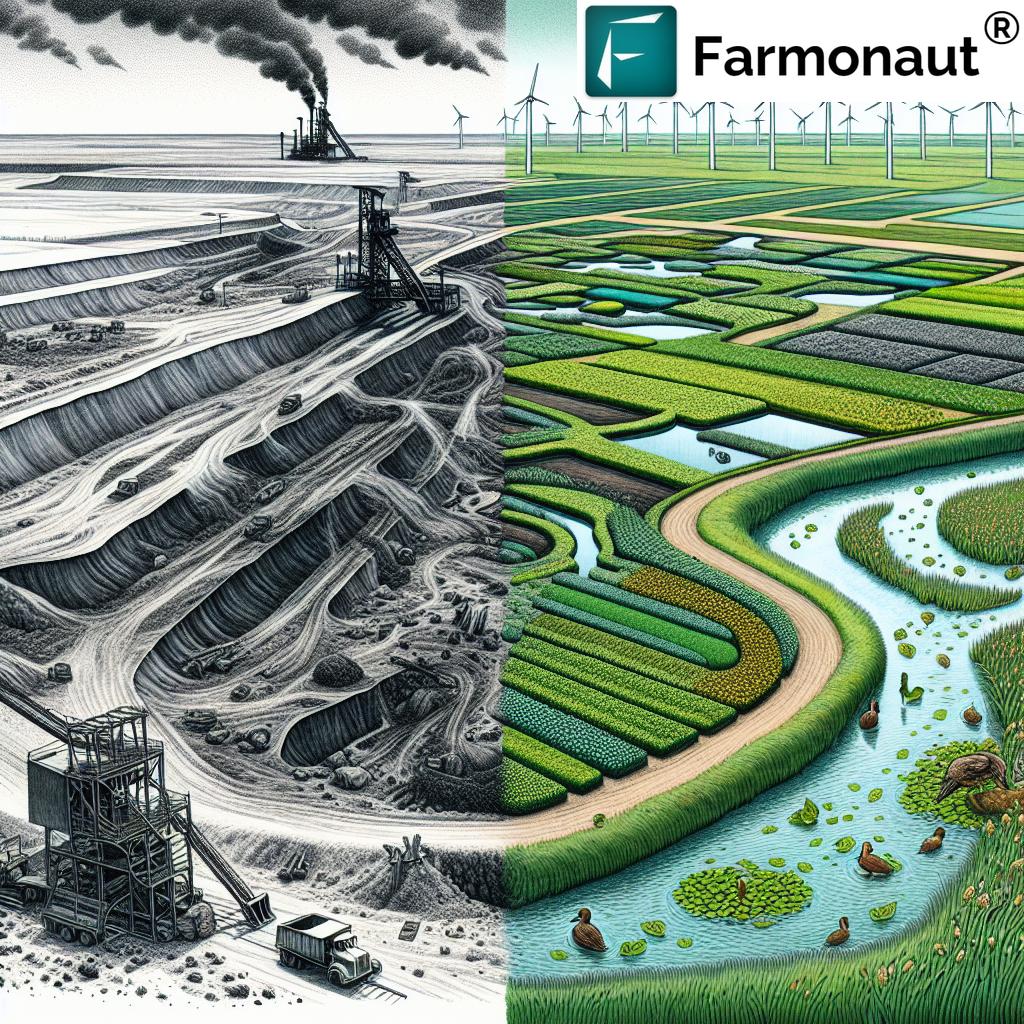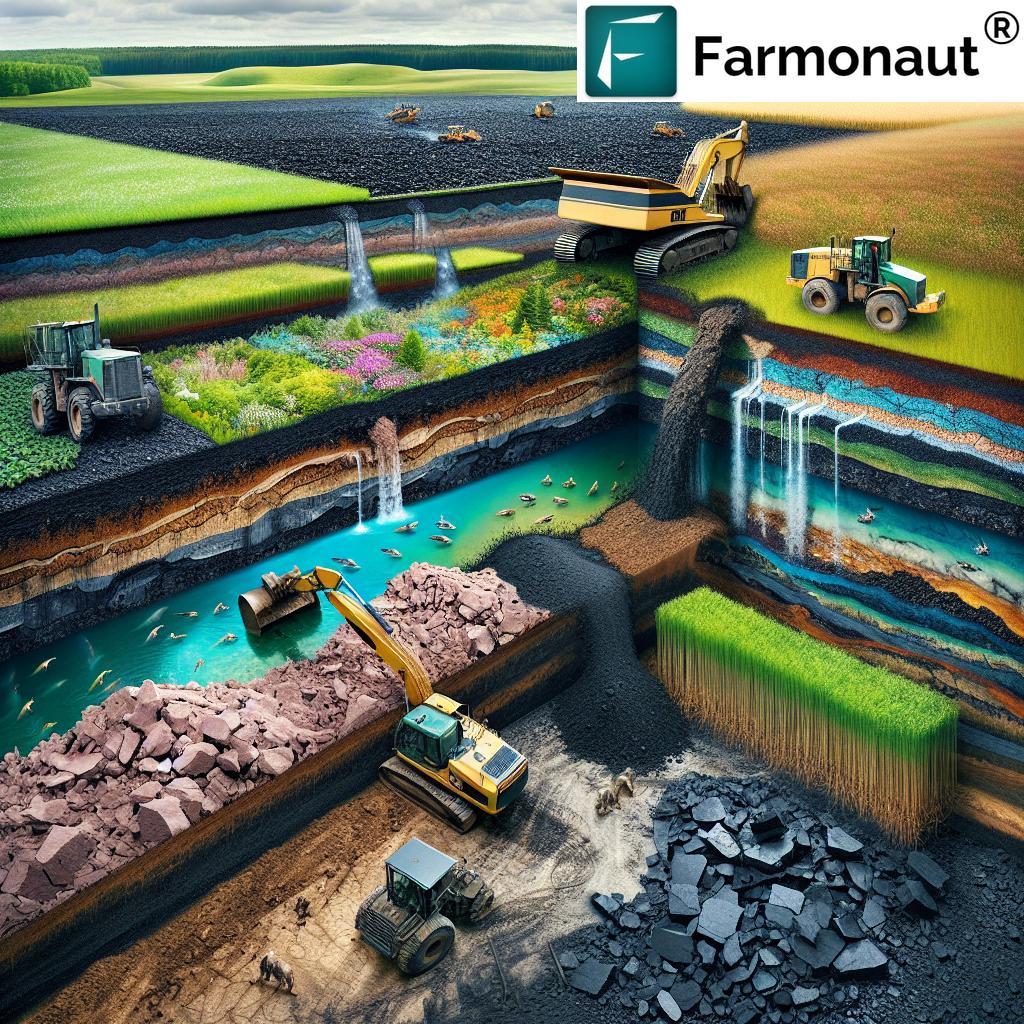Iowa’s Abandoned Mine Reclamation: Transforming Coal Sites into Sustainable Landscapes
“Iowa’s reclamation efforts target over 300 abandoned coal mining sites, covering a total of 13,000 acres.”
Welcome to our comprehensive exploration of Iowa’s remarkable journey in transforming its abandoned coal mining sites into thriving, sustainable landscapes. In this blog post, we’ll delve deep into the state’s innovative land reclamation techniques, abandoned mine restoration efforts, and the profound impact these projects are having on Iowa’s environment and communities.
The Scale of Iowa’s Reclamation Challenge
Iowa faces a significant environmental challenge with over 300 abandoned coal mine sites spanning more than 13,000 acres across the state. These sites, remnants of Iowa’s coal mining history that peaked in the early 1900s, have long posed risks to environmental health and safety. However, through determined efforts and innovative approaches, Iowa is making substantial progress in reclaiming these lands and transforming them into valuable ecological assets.

The Iowa Abandoned Mine Land Reclamation Project
At the heart of Iowa’s reclamation efforts is the Iowa Abandoned Mine Land Reclamation Project, which has been operational since 1983. This initiative is a testament to the state’s long-term commitment to environmental restoration and sustainable land use. Funded through a U.S. Department of Interior program established in 1977, the project utilizes fees from current coal mining operations to support the reclamation of former mining sites.
- Project inception: 1983
- Funding source: Fees from current coal mining operations
- Focus: Rehabilitation of abandoned coal mining sites
The success of this program is evident in the numbers. According to Susan Kozak, director of the Division of Soil Conservation and Water Quality, 120 of these abandoned sites have already been successfully reclaimed. This progress represents a significant milestone in Iowa’s journey towards environmental restoration and highlights the effectiveness of the state’s comprehensive approach to surface mining rehabilitation.
Comprehensive Approach to Reclamation
Iowa’s reclamation efforts encompass a wide range of activities, focusing on key areas such as:
- Soil health improvement
- Water quality management
- Ecosystem restoration methods
- Sustainable land use practices
Each reclamation project typically takes about a year to complete and involves a thorough process:
- Site Assessment: Evaluating the area for endangered species and archaeological concerns
- Design Phase: Creating a comprehensive rehabilitation plan
- Construction: Implementing the reclamation strategies
- Monitoring: Ongoing evaluation of the site’s recovery
This holistic approach ensures that each reclaimed site not only addresses immediate environmental concerns but also contributes to long-term ecological health and sustainability.
Innovative Agricultural Conservation Practices
A key aspect of Iowa’s reclamation efforts is the integration of innovative agricultural conservation practices. These practices are designed to not only restore the land but also to create sustainable, productive landscapes that benefit both the environment and local communities.
- Cover Crop Implementation: Using cover crops to improve soil health and reduce erosion
- Bioreactors: Installing systems to filter and clean water runoff
- Saturated Buffers: Creating areas that naturally filter water and reduce nutrient runoff
- Wetland Restoration: Reestablishing natural wetlands to improve water quality and wildlife habitat
These practices align with Iowa’s broader agricultural conservation goals, as emphasized by Iowa’s Agriculture Secretary, Mike Naig. He notes that these reclamation projects significantly enhance water quality and soil health, contributing to the state’s overall conservation efforts.
Challenges and Successes in Environmental Restoration
The journey of transforming abandoned coal sites into sustainable landscapes is not without its challenges. One of the primary issues faced during reclamation is the presence of highly acidic materials in these abandoned mines. These acidic conditions can severely impact soil quality and water resources, making the restoration process complex and demanding.
However, Iowa’s reclamation efforts have shown remarkable success in overcoming these challenges. The program’s achievements include:
- Neutralizing acidic soil conditions
- Restoring natural vegetation
- Improving water quality in streams and groundwater
- Creating habitats for wildlife, including pollinators
One particularly heartening success story shared by Susan Kozak involves a farmer whose calves began drinking from a restored stream after reclamation. This anecdote powerfully illustrates the tangible ecological benefits of these projects, demonstrating how reclamation efforts can restore not just the land, but entire ecosystems.
“Iowa’s mine restoration projects range from small 30-acre sites to large-scale 162-acre environmental transformation endeavors.”
Scale and Scope of Reclamation Projects
The size and cost of Iowa’s reclamation projects vary widely, reflecting the diverse nature of the abandoned mine sites across the state. Here’s a breakdown of typical project scales:
- Average Project Size: 30 to 50 acres
- Typical Cost Range: $500,000 to $800,000
- Large-Scale Projects: Can exceed $1 million
A notable example of a large-scale project is the ongoing reclamation near Pella, which spans 162 acres and is projected to cost nearly $4 million. This project showcases the ambitious scope of Iowa’s reclamation efforts and the significant investment being made in environmental restoration.

Funding and Legislative Framework
The success of Iowa’s reclamation efforts is underpinned by a robust funding mechanism and legislative framework. Key aspects include:
- Federal Funding: The primary source of funding for these projects
- 2021 Infrastructure Bill: Provided a significant boost to financial support
- Surface Mining Control and Reclamation Act of 1977: Established the legal framework for reclamation efforts
The recent changes in federal funding, particularly the boost from the 2021 infrastructure bill, have allowed Iowa to significantly scale up its reclamation activities. This increased financial support enables the state to undertake multiple projects simultaneously, accelerating the pace of environmental restoration across Iowa.
Long-Term Impacts on Local Ecosystems and Communities
The long-term impacts of Iowa’s reclamation projects extend far beyond the immediate environmental benefits. These efforts are creating lasting positive changes for local ecosystems and communities:
- Enhanced Biodiversity: Restored lands support a variety of plant and animal species
- Improved Water Resources: Cleaner streams and groundwater benefit both wildlife and human communities
- Pollinator Support: Reclaimed lands often become ideal habitats for important pollinator species
- Community Health: Elimination of environmental hazards improves overall public health
- Economic Benefits: Restored lands can support sustainable economic activities like eco-tourism
These impacts demonstrate how Iowa’s reclamation efforts are not just about fixing past environmental damage, but about creating a more sustainable and resilient future for the state.
The Role of Technology in Land Recovery Efforts
As we look to the future of land reclamation and sustainable agriculture, technology plays an increasingly crucial role. Innovative solutions like those offered by Farmonaut can significantly enhance the efficiency and effectiveness of land recovery efforts.
Farmonaut’s satellite-based farm management solutions provide valuable tools for monitoring and managing reclaimed lands. Through their  , users can access real-time data on vegetation health, soil moisture levels, and other critical metrics. This information is invaluable for tracking the progress of reclamation projects and ensuring the long-term success of restored ecosystems.
, users can access real-time data on vegetation health, soil moisture levels, and other critical metrics. This information is invaluable for tracking the progress of reclamation projects and ensuring the long-term success of restored ecosystems.
Key features that can support land reclamation efforts include:
- Satellite-Based Crop Health Monitoring
- AI-driven Advisory Systems
- Resource Management Tools
- Carbon Footprint Tracking
For those interested in leveraging these technologies for reclamation projects or sustainable agriculture, Farmonaut offers accessible solutions through their  and
and  .
.
Comparative Analysis of Iowa Mine Reclamation Projects
| Project Name/Location | Site Size (acres) | Primary Reclamation Focus | Key Conservation Practices | Estimated Duration | Notable Outcomes |
|---|---|---|---|---|---|
| Pella Large-Scale Project | 162 | Ecosystem Restoration | Wetland creation, native vegetation planting | 2-3 years | Significant improvement in water quality, habitat restoration |
| Des Moines River Valley Site | 45 | Soil Health | Cover crops, bioreactors | 1 year | Reduced soil erosion, improved nutrient retention |
| Southern Iowa Small Site | 30 | Water Quality Management | Saturated buffers, stream restoration | 9 months | Restored stream health, improved aquatic habitats |
| Central Iowa Mixed-Use Project | 75 | Sustainable Land Use | Agroforestry, pollinator habitats | 18 months | Increased biodiversity, potential for sustainable agriculture |
This table provides a snapshot of the diverse reclamation projects underway in Iowa, highlighting the varied approaches and outcomes across different sites. It demonstrates the comprehensive nature of Iowa’s restoration initiatives and the tailored strategies employed based on each site’s specific needs and potential.
The Future of Iowa’s Environmental Restoration
As Iowa continues to make significant strides in reversing decades of mining-related degradation, the future of environmental restoration in the state looks promising. The ongoing success of these reclamation projects sets a powerful precedent for similar efforts across the United States and beyond.
Key aspects shaping the future of Iowa’s reclamation efforts include:
- Continued Federal Support: Sustained funding will be crucial for ongoing and future projects
- Technological Advancements: Incorporation of new technologies like those offered by Farmonaut can enhance monitoring and management of reclaimed lands
- Climate Change Considerations: Future projects may need to account for changing climate patterns
- Community Engagement: Increased involvement of local communities in reclamation planning and execution
For those interested in leveraging advanced technologies for environmental monitoring and sustainable land management, Farmonaut offers comprehensive solutions. Their API and API Developer Docs provide powerful tools for integrating satellite-based monitoring into reclamation and conservation efforts.
Conclusion
Iowa’s journey in transforming abandoned coal sites into sustainable landscapes is a testament to the power of determined environmental stewardship. Through innovative land reclamation techniques, comprehensive abandoned mine restoration efforts, and the integration of agricultural conservation practices, Iowa is not just repairing past environmental damage but is creating a blueprint for sustainable land use and ecosystem restoration.
The success of these projects demonstrates the potential for positive environmental change when backed by strong legislative support, adequate funding, and innovative technologies. As Iowa continues to reclaim and restore these lands, it sets an inspiring example for environmental restoration efforts worldwide, proving that with commitment and innovation, even the most challenging environmental legacies can be transformed into assets for future generations.
FAQ Section
Q1: What is the main goal of Iowa’s abandoned mine reclamation projects?
A1: The main goal is to transform former coal mining sites into sustainable, environmentally healthy landscapes, improving soil health, water quality, and ecosystem function.
Q2: How are these reclamation projects funded?
A2: The projects are primarily funded through a federal program established by the U.S. Department of Interior in 1977, using fees collected from current coal mining operations.
Q3: How long does a typical reclamation project take?
A3: Most reclamation projects take about a year to complete, though larger projects can extend to 2-3 years.
Q4: Can reclaimed land be used for farming?
A4: While reclaimed lands are generally not suitable for intensive farming, they can support limited agricultural activities like grazing and are often ideal for pollinator plants and wildlife habitats.
Q5: How does technology contribute to these reclamation efforts?
A5: Advanced technologies, such as satellite-based monitoring systems offered by companies like Farmonaut, can play a crucial role in assessing and managing reclaimed lands, providing real-time data on vegetation health and soil conditions.

















